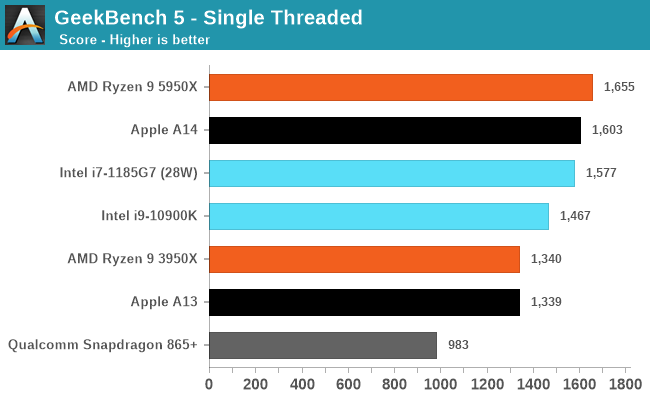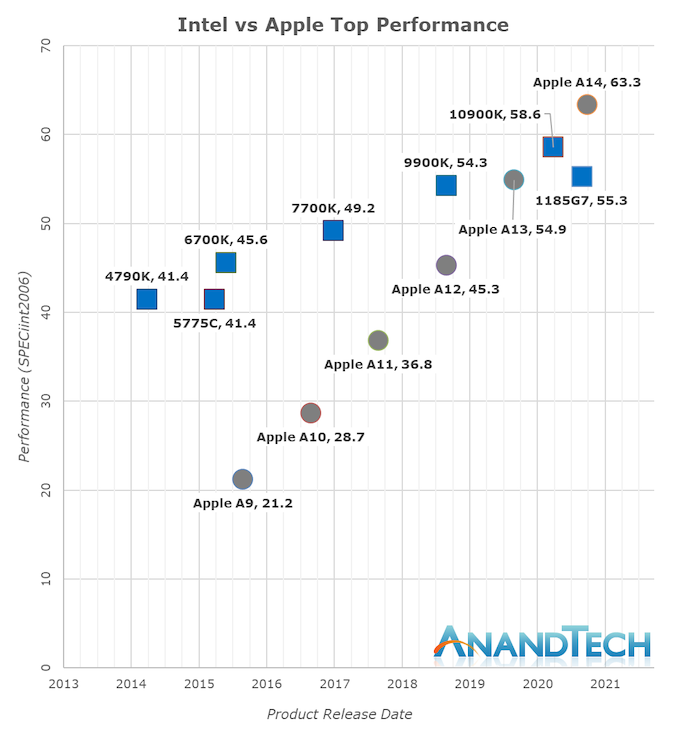Apple Announces The Apple Silicon M1: Ditching x86 - What to Expect, Based on A14
by Andrei Frumusanu on November 10, 2020 3:00 PM EST- Posted in
- Apple
- Apple A14
- Apple Silicon
- Apple M1
From Mobile to Mac: What to Expect?
To date, our performance comparisons for Apple’s chipsets have always been in the context of iPhone reviews, with the juxtaposition to x86 designs being a rather small footnote within the context of the articles. Today’s Apple Silicon launch event completely changes the narrative of what we portray in terms of performance, setting aside the typical apples vs oranges comparisons people usually argument with.
We currently do not have Apple Silicon devices and likely won’t get our hands on them for another few weeks, but we do have the A14, and expect the new Mac chips to be strongly based on the microarchitecture we’re seeing employed in the iPhone designs. Of course, we’re still comparing a phone chip versus a high-end laptop and even a high-end desktop chip, but given the performance numbers, that’s also exactly the point we’re trying to make here, setting the stage as the bare minimum of what Apple could achieve with their new Apple Silicon Mac chips.

The performance numbers of the A14 on this chart is relatively mind-boggling. If I were to release this data with the label of the A14 hidden, one would guess that the data-points came from some other x86 SKU from either AMD or Intel. The fact that the A14 currently competes with the very best top-performance designs that the x86 vendors have on the market today is just an astonishing feat.
Looking into the detailed scores, what again amazes me is the fact that the A14 not only keeps up, but actually beats both these competitors in memory-latency sensitive workloads such as 429.mcf and 471.omnetpp, even though they either have the same memory (i7-1185G7 with LPDDR4X-4266), or desktop-grade memory (5950X with DDR-3200).
Again, disregard the 456.hmmer score advantage of the A14, that’s majorly due to compiler discrepancies, subtract 33% for a more apt comparison figure.

Even in SPECfp which is even more dominated by memory heavy workloads, the A14 not only keeps up, but generally beats the Intel CPU design more often than not. AMD also wouldn’t be looking good if not for the recently released Zen3 design.

In the overall SPEC2006 chart, the A14 is performing absolutely fantastic, taking the lead in absolute performance only falling short of AMD’s recent Ryzen 5000 series.
The fact that Apple is able to achieve this in a total device power consumption of 5W including the SoC, DRAM, and regulators, versus +21W (1185G7) and 49W (5950X) package power figures, without DRAM or regulation, is absolutely mind-blowing.

There’s been a lot of criticism about more common benchmark suites such as GeekBench, but frankly I've found these concerns or arguments to be quite unfounded. The only factual differences between workloads in SPEC and workloads in GB5 is that the latter has less outlier tests which are memory-heavy, meaning it’s more of a CPU benchmark whereas SPEC has more tendency towards CPU+DRAM.
The fact that Apple does well in both workloads is evidence that they have an extremely well-balanced microarchitecture, and that Apple Silicon will be able to scale up to “desktop workloads” in terms of performance without much issue.
Where the Performance Trajectory Finally Intersects
During the release of the A7, people were pretty dismissive of the fact that Apple had called their microarchitecture a desktop-class design. People were also very dismissive of us calling the A11 and A12 reaching near desktop level performance figures a few years back, and today marks an important moment in time for the industry as Apple’s A14 now clearly is able to showcase performance that’s beyond the best that Intel can offer. It’s been a performance trajectory that’s been steadily executing and progressing for years:
Whilst in the past 5 years Intel has managed to increase their best single-thread performance by about 28%, Apple has managed to improve their designs by 198%, or 2.98x (let’s call it 3x) the performance of the Apple A9 of late 2015.
Apple’s performance trajectory and unquestioned execution over these years is what has made Apple Silicon a reality today. Anybody looking at the absurdness of that graph will realise that there simply was no other choice but for Apple to ditch Intel and x86 in favour of their own in-house microarchitecture – staying par for the course would have meant stagnation and worse consumer products.
Today’s announcements only covered Apple’s laptop-class Apple Silicon, whilst we don’t know the details at time of writing as to what Apple will be presenting, Apple’s enormous power efficiency advantage means that the new chip will be able to offer either vastly increased battery life, and/or, vastly increased performance, compared to the current Intel MacBook line-up.
Apple has claimed that they will completely transition their whole consumer line-up to Apple Silicon within two years, which is an indicator that we’ll be seeing a high-TDP many-core design to power a future Mac Pro. If the company is able to continue on their current performance trajectory, it will look extremely impressive.











644 Comments
View All Comments
Quantumz0d - Tuesday, November 10, 2020 - link
I will wait for that ARM gaming PC soon, wonder who is going to make it, Apple / Nuvia / Centriq / Qcomm / Samsung / Huawei / Mediatek / Marvell ? Please let me know where can I buy that.AArch64 emulates the x86 faster than native, can you please show me some benchmark or the application that it is doing, I want to see it. Please don't write some useless HW trash or SW or compiler math. A simple benchmark or a video will do, much easier for all of us.
grant3 - Tuesday, November 10, 2020 - link
"AArch64 emulates x86 faster than x86 runs software natively. "I'm highly doubtful, especially since this claim has no context. Which AAarch64 chip vs. which x64 chip? (I assume you mean x64 because x86 has been superseded for so long)
If it's already proven that AArch64 is the fastest at running x64 code, then why are you and others not already buying them for their gaming rigs?
Calin - Wednesday, November 11, 2020 - link
Basically the Rosetta-2 will run x86 code on M1 cores fast enough that the better M1 graphics cores will be able to run graphically intensive applications faster than on the 2018 MacBook Air.Also, this is a "work done per watts used" comparison, and the 5nm TSMC processor is better than Intel's 2018 14 nm.
Could an unrestricted x86 behemoth with graphic similar to M1's integrated do better than the M1 running emulation? I bet it is, however the comparison was between the 2018 MacBook Air and the 2020 MacBook Air (so total power limited to some 10 Watts).
Speedfriend - Wednesday, November 11, 2020 - link
AArch64 emulates x86 faster than x86 runs software natively.That is not what they said, they said that in emulation it ran faster than on the old Mac's, which In this case had 2018 Intel processor or dual core.
It is not faster than a current Intel chip
Ladis - Wednesday, November 11, 2020 - link
I remember when Apple switched from Motorola to PowerPC the lowest spec PPC PowerBooks were slow at emulating the Motorola code because the emulator + the app's code didn't fit in the CPU cache. However it's the opposite this time - Apple Silicon's cache is huuuuge. Also as others stated, it's omparing to years old TDP-limited MacBook.Spunjji - Thursday, November 12, 2020 - link
Backwards compatibility isn't going to be a good enough reason for x86 to stick around forever - especially not if power/performance ends up tilting so far towards ARM designs.hlovatt - Tuesday, November 10, 2020 - link
@vladx That is a utterly unfair comment. Anandtech have done in depth independent testing of the A14 chip that is beyond anything else you will find. I think you should apologise to them and retract your comment.Spunjji - Thursday, November 12, 2020 - link
Whereas I have come to expect this sort of baseless accusation from you. I don't understand why you still come here now that reality is increasingly poorly aligned with your team-sports fantasies.augustofretes - Tuesday, November 10, 2020 - link
There's no performance lost at all. The M1 is obviously faster than anything Intel can put on a Macbook Air or Macbook Pro. The A14 is stuck on a phone and its giving processors with a much higher TDP to work with a run for their money.BlackHat - Tuesday, November 10, 2020 - link
Apple compare the M1 against their 2018 MacBook with SkyLake and LPDDR3, no even the 2020 model with Ice Lake, a chip that is heavily throttle, why this if is given "a run for their money"?